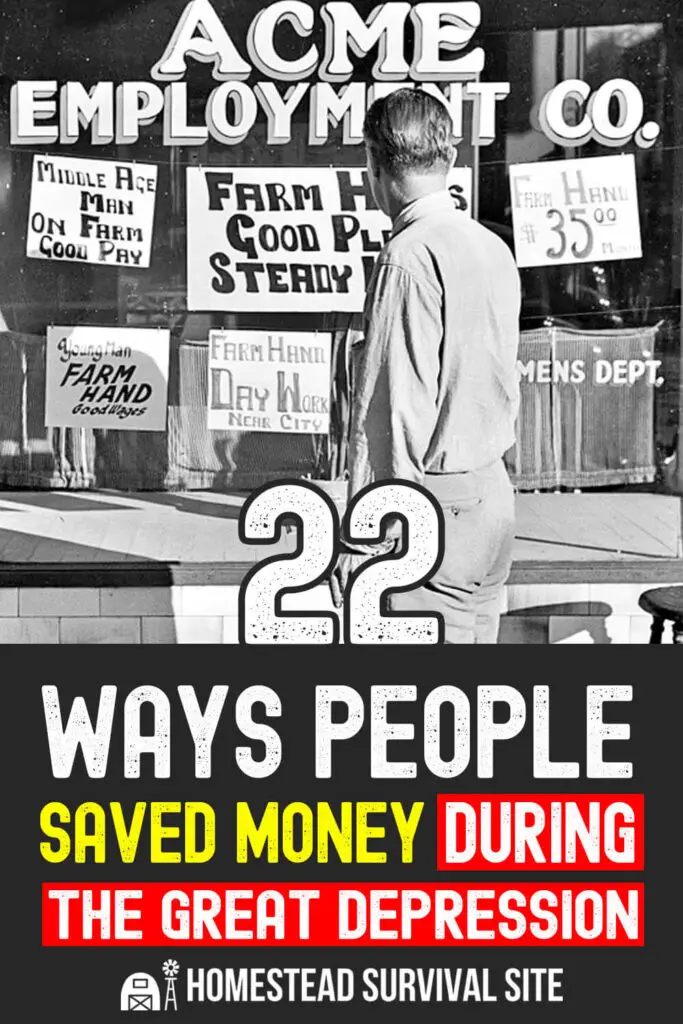Estimated reading time: 13 minutes
The ‘Roaring Twenties’ is what they called that prosperous everyone-has-a-fur-coat period that is the 1920s. Everyone was spending, and there were continuous advances in electricity, technology, automobiles, and the arts. But what goes up must come down.
The U.S. was in for a rough ride the following decade when the country experienced the worst recessions in history, now known as the Great Depression. From riches to rags, Americans went from thriving to surviving by bartering their valuables, firing the hired help, getting their hands dirty, and recycling any useful material they could find.
America learned that during economic turmoil, no one is safe.
So why does The Great Depression matter to us nearly a century later? Well, it looks like a recession or possibly another great depression is right around the corner.
If that is true, we need to begin studying and learning from our grandparents, adapting the lessons they learned to fit our needs today.
Want to save this post for later? Click Here to Pin It On Pinterest!
1. Don’t Pay For Something You Can Do Yourself
The crash of Wall Street in 1929 was a big slap in the face to everyone who was living a lavish and luxurious lifestyle. Though only around 16% of American households actually invested in stocks, it caused business uncertainty that left everyone nervous about their income and employment. Stocks went down, and self-reliance went up.
Services that Americans would typically pay other people to do, they started doing themselves. This applies to virtually anything from fixing your car to making your own bread and pasta. Make a list of all the things you are currently paying someone else to do and see how many of those skills you could learn to do on your own.
2. Start a Garden
When unemployment rates quickly reached 25%, citizens no longer had the funds to go to the local market to fill their pantry. Growing and raising their own food became the obvious solution.
Most housewives then created their own kitchen garden where they grew vegetables and herbs. Some states even created gardening programs, and local towns converted open lots into community gardens.
Can you do this? No doubt! Even if you live in an apartment building, you can still grow things in buckets: tomatoes, herbs, beans, lettuce, spinach, and strawberries, to name a few!
Don’t have enough space? Take it upon yourself to find an unused government plot and propose a community garden! You’ll be surprised by how many of your neighbors will get behind this idea.

3. Buy the Whole Chicken
You get more bang for your buck when you buy the whole chicken, rather than buying the chicken breast or legs separately. Back in the day, this was a well-known fact. Not only was it better value to buy and use the whole chicken, but households came to appreciate all of the trimmings and carcasses of a chicken. These parts can be used to make chicken broth, soups, pates, and more.
Those who had space began to raise their own chickens and didn’t waste perfectly edible parts by being picky eaters.
Stretching your ingredients was a staple of 1930’s households and it should be the same for households of the 21st century.
4. Substitute your Meat
No matter the era, meat is expensive. During the Great Depression, you’d rarely find beef on a family’s table; pork and chicken weren’t that common either. To compensate for this expense, home cooks would use other proteins to fill the gaps in nutrition and flavor. Adding more beans, eggs, and even breadcrumbs was common. People opted for more filling and long-lasting recipes like macaroni and casseroles.
Start practicing your casserole making skills and reach into the backs of your pantry to see what random ingredients you can add.
5. Throw Everything on the Plate
People back then didn’t just pick the good parts in their ingredients and throw the rest out. A lot of them used every edible part possible, many of which you probably don’t see much today. Animal organs like the liver, gizzard, and heart weren’t left out.
There’s no reason that you can’t do the same today. In fact, a lot of other countries have no problem eating the organs. Organs are packed with healthy nutrients, so start experimenting in the kitchen! Learning how to cook with gizzards is just a matter of practice.
6. Repurpose your Leftovers
In another angle, you could probably call the Great Depression the golden age of leftovers. More than just reheating last night’s dinner, they’d repurpose the food into a whole new dish. This is why they made a lot of stews, pot pies, meatloaf, and blanketed dishes–because they could easily disguise the leftovers into something new. It’s amazing how creative meals became during the Great Depression!
Can you do this at home? Yes, just get some glass or stainless-steel containers. If you’re buying plastic, make sure it’s BPA Free!

7. Get to Know your Neighbor
With an estimate of 15 million people who lost their jobs during the Great Depression, very few were spared from the economic crisis. Asking help from your neighbors (and offering help in return) was not uncommon. Communal dinners and exchanging homemade goods was something people had to do to get by. Maybe one neighbor has the garden and the other has the chicken – together they have a feast.
If you’re already friendly with your neighbors today, suggest a weekly potluck. If you don’t know your neighbors, throw a cookout once a month to get those community vibes going. And even better, if you have survivalist neighbors, frankly discuss how you can work together when times get tough.
8. Borrow Instead of Buy
Remember the good old days of asking your neighbor to borrow a cup of sugar or a couple of eggs. During tough times, this was the norm.
If you can’t buy something, then check if you can borrow it from your neighbor. This does not mean asking to borrow money (since nobody had that, anyway) but just simple household items or things they could easily spare. There is a lot of etiquette that comes with asking to borrow, however. It doesn’t matter how close you and your neighbor are, it’s important to stay mindful of how reasonable your request is and how often you are asking to borrow.
To keep this line of borrowing open, find a way to say thank you every time with vegetables from your garden or sending your kid over to mow their lawn.
9. Fix Instead of Replace
Wives and teenagers had to learn how to sew and mend their clothes. If they didn’t have enough items to fix it, they used things from around the house like cardboard for the soles of the shoes – even though it wasn’t the most comfortable or convenient solution.
If you can fix something before or until you can buy a new one, then do it.
10. Dress in Layers
During the Great Depression, electricity was a big expense. Instead of cranking the heat up – layering was the way to stay warm, even indoors. This meant wearing socks inside the house, throwing extra warm blankets on the bed, and wearing Long Johns under jeans.

Actually, you can still see a lot of homeless people on the streets doing this today… because it works.
11. Give Up Your Car
In the 1920’s, the automobile business was booming! But once the 30's hit, demand dropped as many people couldn’t afford to fuel, maintain, or even buy a car to begin with. For those who could, they’d use bicycles to go to work, go to the store, and jaunt about town.
Can you do this? Try it. Distance, routes, and availability of other modes of transportation need to be considered, obviously. Take inventory of your daily routes and see if any of them could be replaced with a bicycle.
12. Postpone Major Life Decisions
The depression affected not only food prices but also fertility, marriage, and divorce rates. Children born to women aged 15 to 44 dropped by 20%, marriage rates dropped to 22%, and the divorce rate dropped to 25% in the US.
Can you do this today? With some willpower, of course. Consider throwing a smaller wedding. Take into account that it costs over $200k to raise a child from infancy. And… well, maybe get that divorce anyways.
13. Work from Home
When families couldn’t afford the rent and utilities of their formal offices, many professionals decided to practice at home. This meant people like dentists, doctors, and lawyers started moving their offices to their own homes to cut costs.
In our current age of technology, it is very much possible to work remotely. In fact, numerous studies have shown that working from home can actually be more productive and bring you more personal and professional fulfillment.
14. Pay With Produce
During the Great Depression, as prices continued to drop, around 750,000 farmers were going bankrupt and losing their farms. The ones that remained tried to salvage what they could and desperately held on to the few workers they had. A lot of times, this meant paying their workers with produce and valuables instead of money.
Can you do this, too? When SHTF, workers may be willing to accept food and accommodation, and agricultural education as payment. In fact, there is a booming trend of volunteers and farmers who already do this today. Look into organic WWOOFing or WorkAway.com.

15. Find Free Entertainment
The film industry, too, took a hit when viewership peaked to 90 million tickets in 1930, and rapidly declined soon after. People had to sacrifice some of their hobbies because, well, they just couldn’t afford to watch movies anymore. Instead, they opted for hobbies like board games or reading in public libraries. Free community concerts and events also became quite popular.
Today, there’s definitely a lot more free or cheap entertainment options out there. You can check out your local community centers or check out free entrance dates to museums. Have a big family? Put on plays or scavenger hunts. Get creative!
16. Wash your Clothes Less Often
If it wasn’t smelly or stained, it wasn’t going to be washed. During the economic crisis, no one was judging each other for wearing the same shirt twice or having wrinkles in their blouse. Sounds nice, doesn’t it?
Save the water. Save the washing powder. Save the energy. When resources are limited, you must alter your habits.
17. Vagabond
When the resources at home were sparse, many humans did what any instinctive animal would do – they began to forage. The vagabonding trend came alive with able-bodied people taking to a nomadic life, living in a tent, hopping on freight trains, and carrying just the necessities on their back. Living off the land was the goal, and so these people would pick wild berries, find edible plants or set traps for rabbits. Life was more plentiful in nature than it was in the city.
Depending on where you live, this could work. The Pacific Northwest is a great place for this lifestyle because there are still lush forests filled with food and rivers full of fish. One important factor to consider, however, is the hunting and fishing regulations in the area. Are they still being enforced? Find a way to work with the regulations. Is the government in total mayhem? Then no one is going to stop you.
18. Make Your Own Stuff
Ask your grandparents, and they probably know all the best ingredients for a good cleaner. Instead of buying stain remover, it was a lot cheaper to just mix some baking soda and lemon. Back then, people would even make huge blocks of soap and just slice off small bits to use every day. These DIY cleaning recipes save tons of money and are just as effective as store-bought cleaning supplies. Why not take advantage?
For more ideas, here's our list of everyday items you can make yourself.
19. Buy in Bulk
During the Great Depression, families carefully planned out everything they needed for the weeks when it came to meals and household necessities. This means that mindlessly shopping was out of the question. Each penny was planned and put to good use.
It’s common knowledge today that buying in bulk will save you a lot more. You can start stocking up now with canned goods or dehydrated fruits, soap, and other non-perishable items. Look into coupon clipping and fill an emergency pantry with the necessities. There are tons of ways to save money at the grocery store if you just know how to find the best deals.
20. Shop Late To Get The Best Deals
At the end of the day, bakeries and grocery stores discount the perishable or short shelf-life items in stock that day. This became a nifty trick for housewives who would do their shopping at night, rather than in the morning.
It might mean not getting the freshest bread, but it didn’t matter as long as it could fill their children’s stomachs. This practice is still alive and well today. Start learning which establishments do this and alter your shopping habits.
21. Keep a Budget Diary
People used to keep track of every little thing back then. Some people would carry a little pocket notebook where they keep track of their expenses for the month. If you feel like you’re going to be short on cash for the month, then you should try doing this, too. And no, don’t use an app. Physically writing things down will have more of an impact on your habits.
22. Embrace Odd Jobs
Doctors, lawyers, butchers… no one was too good for a side job back in the Great Depression. That’s because no job was spared from cuts and cutbacks. Many incomes were cut by 40% or even cut completely.
To put food on the table, many people began to take up side jobs. Housewives made homemade products and sold them on the side of the road, and children worked in farms and factories. Today, you might not need to go this far. However, realize that there is no shame in a side hustle.
Conclusion
There's a lot we can learn from The Great Depression. When the dollar stops going as far and companies start making major cuts, resourcefulness will be your most valuable asset.
Don’t buy into the false security that your job may give you. Government sectors, teaching jobs, the entertainment industry, factory work – they are all at risk of being cut when the bubble bursts. The faster you accept these truths, the quicker you’ll be to adapt when history repeats itself.
You can and you should begin preparing now. Whether that be stockpiling survival foods, learning basic hunting techniques, or find ways to stretch your dollar – recognize that it's only a matter of time before the next great recession (or depression).
Luckily, we have the lessons of the past to use as a template when it comes time to fend for ourselves.
Like this post? Don't Forget to Pin It On Pinterest!










Interesting, so many of us are already living this way. Out of necessity.
My parents grew up after the great depression.But they taught me all the things mentioned in this article. Too many young people in the U.S. don’t believe in these ideas. That’s one of the reasons why we have so much garbage and junk. Many Americans also like to live beyond their means. They buy stuff (on credit) that costs more than they can afford. That was one of the reasons why our last recession happened.
Check out Clara great depression cooking on UTube . I am also doing many of the suggestion s listed and may God bless each one of us including our great President . Evilness prevails but God always win so let’s be in the Godly side of life
Great article and more timely than ever. I really learned a lot, and found that I’m doing a lot of these things already.
One thing I would add would be to never buy new. Check tag sales, thrift stores and yard sales for good quality used items for low prices, especially children’s clothing and toys, books.
Another thing to do is to drive through neighborhoods before the trash is picked up – useable items are often left by the curb. If you see anyone, ask permission to take from their trash pile. Many people will also have a ” For Free -Take” pile after packing up for a move, remodeling, yard sales, etc.
This article is a mixture of personal opinion with a few facts thrown in for good measure. Seriously, where are you getting your information from? I’d like you to post your sources in the article itself. The divorce rate in the 1930s did not drop to 25%! Hardly anyone got divorced at that time in the first place. Stop stating personal opinion as historical fact. The readers of your articles are not as ignorant as you evidently think we are.
Actually it did… you’ve misinterpreted or confused Kitty’s statement. It was previously 30 something per cent. So 25% isn’t a huge drop. And it most likely encompasses official stats AND unofficial. In other words one partner would walk away (usually the man) but would be counted in the stats.
Ya the Forbes article about the next recession was from 2018 lol. Maybe an update?
I get the weirdest looks whenever I tell about how in my Dad’s family, they were only allowed to use two sheets of toilet paper at a time and it had to be folded at least three times.
When the next great depression hits, and it is on its way the young will get quite a shock.
Why are there so many pintrest articles about a potential market crash in America?
Too many Americans believe that if a business venture does not earn $1,000,000 in one year; you’re a loser. How long did it take Ford motors to become as sucessful as it is today?